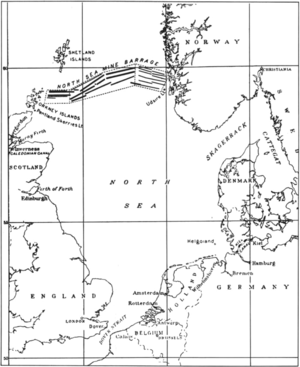North Sea Minesweeping Detachment
| North Sea Mine Barrage | |||||
|---|---|---|---|---|---|
| Part of World War I | |||||
 |
|||||
|
|||||
| Belligerents | |||||
|
|
|
||||
The North Sea Mine Barrage, also known as the Northern Barrage, was a large minefield laid easterly from the Orkney Islands to Norway by the United States Navy (assisted by the Royal Navy) during World War I. The objective was to inhibit the movement of U-boats from bases in Germany to the Atlantic shipping lanes bringing supplies to the British Isles. Rear Admiral Lewis Clinton-Baker, commanding the Royal Navy minelaying force at the time, described the barrage as the "biggest mine planting stunt in the world's history;" but larger fields containing more mines were laid during World War II.
The idea of a mine barrage across the North Sea was first proposed in the summer of 1916 by Admiral Reginald Bacon and was agreed at the Allied Naval Conference on 5 September 1917. The Royal Navy—and in particular Admiral Beatty as Commander in Chief of the Grand Fleet—was skeptical about the value of the operation and did not feel it justified the large logistical and manufacturing commitment required. A minefield across the North Sea would require mining water 900 feet (270 m) deep while no previous minefield had been established in waters more than 300 ft (91 m) deep. A minefield across the North Sea had been estimated to require 400,000 conventional anchored mines. An "antenna" mine developed in July 1917 was effective at the assumed maximum submarine depth of 200 ft (61 m); and 100,000 of these new Mk 6 mines would be adequate to form the North Sea mine barrage.
The United States was altogether more enthusiastic about the operation as the loss of trans-Atlantic shipping was a major domestic concern and this plan allowed the United States to play an active part in tackling this while playing to their industrial strength and with minimal risk of American casualties. Assistant Secretary of the Navy Franklin D. Roosevelt appealed directly to President Woodrow Wilson to overcome opposition to the project from Vice Admiral William Sims, who commanded all United States naval forces in Europe. The U.S. Navy tendered an order for the Mk 6 mines in October 1917 with 80,000,000 ft (24,000,000 m) of steel wire rope required to moor the mines to the seabed. Project spending of $40 million was shared among 140 manufacturing contractors and over 400 sub-contractors. All mine components other than wire rope, explosives, and detonating circuitry were manufactured by Detroit automobile firms. Eight civilian steamships were converted to minelayers; and another 24 mine carrying freighters, sailing at a rate of two or three per week, were required to transport manufactured mine components to assembly depots in Scotland.
...
Wikipedia
